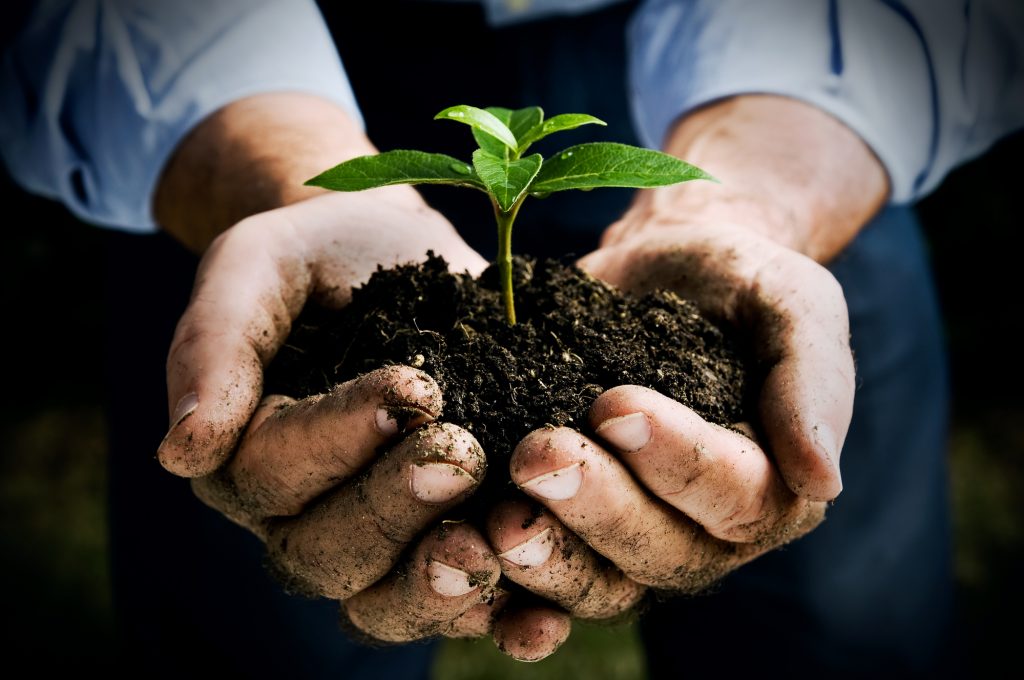
Spring is in the air, flowers are blooming, and hopefully, your lawn is looking lush and green. Unless it isn’t. Oh no! So what’s a homeowner to do? If you’re after that perfect lawn, we’ll let you in on a little secret: it’s all about healthy soil. Yes, it can be that simple. You’ve got to start down with the dirt to produce a thick, healthy, green lawn. But don’t worry, we have you covered with all the information, tips, and tricks to ensure your soil and lawn get the best treatment.
What makes a healthy lawn?
A healthy lawn requires healthy soil, plain and simple. And much like people, your lawn needs to “eat” well to be healthy. But instead of counting macros or getting into a cardio routine, your lawn needs nutrient-rich soil. These nutrients bolster your lawn and enable it to resist drought, weeds, and other pests. Healthy soil is rich in beneficial insects and bacteria. This complex food web works naturally to keep grass healthy. Luckily, there are plenty of ways to maintain a healthy, “well-fed” lawn without chemical pesticides and synthetic fertilizers. To get your lawn started on a safe, healthy routine, you’ll first want to assess current health and needs and take it from there.
How can you tell if your soil is healthy?
The most obvious red flag for soil health is if your lawn is looking thin, patchy, and brown. Dig in a bit and check out your soil to see what’s going on. Healthy soil should show signs of underground animal and plant activity, such as earthworms and fungi. If your soil is rich in these nutrients it will also tend to be darker and crumble off of the roots of plants or lawn patches you pull up. A healthy, spread-out root system is also a sign of good soil.
However, if you dig up a patch and the soil comes up in hard clumps and/or you can see that the roots are stunted, you may have a problem. Another possible red flag is if you can see water gathering on the soil surface, as this is also a sign of soil compaction.
What is the healthiest type of soil?
The healthiest type of soil is one called “loam.” It is an ideal garden and lawn soil because it is crumbly, full of organic matter, and retains moisture yet still drains well. This is what you will be working toward; this is “good” soil. Loam is a balance of sand, silt, and clay. If you’re not sure if your soil is healthy or not, you can test it.
Your ideal soil will also depend on the variety of turf you have. For example, Bermuda grass, a hearty choice for the southeast, grows best when soil pH is between 5.8 and 7.0. It can also tolerate more alkaline conditions. If you have overly acidic soil, regular applications of lime may be needed to keep pH at optimal levels. Otherwise, Centipede grass may be a good alternative.
What are the types of soil?
There are twelve “orders” of soils, but in regards to lawns, there are really two main types that balance out in slightly different proportions based on your lawn care needs. These two groups are heavy and light soils. Heavy soil contains more clay and is sticky and hard to work, but is generally more fertile. Because it’s heavier and denser, such soils tend to remain cold and wet in spring and need grit or coarse organic material to bring in air and help grassroots remain healthy. Alternatively, sandy or silty soils are considered ‘light’ soils because they are permeable, water-draining types of soils.
What is the difference between topsoil and lawn soil?
Let’s get into the nitty-gritty of soil. Topsoil is the top layer of the soil profile, though this can vary greatly depending on the type of vegetation, client, subsoil, and land use. Loam is a subcategory of topsoil. Therefore loam is topsoil, but topsoil is not always loam. Clear as mud, right? Loam is a mixture of sand, silt, clay, and organic matter. A medium loam has a makeup of 40% sand, 40% silt, and 20% clay according to the USDA. In general, organic content is less than 10% in naturally occurring soils. Many soil sellers normally make additions of compost if the organic content is too low in the soil they are offering. Topsoil is more of a general-purpose landscape material, and can also be used to level low spots in the lawn in preparation for sod installation.
How do I make my lawn soil healthy?
Now that we’ve covered the basics of soil types, problems, and needs, let’s cover how to make your lawn healthy. The number one question homeowners have is, “How can I make my grass thicker and greener?” Well, that might require improving poor soil and bringing it back to health.
To ensure soil health, you’ll want to focus on two main areas: watering and fertilization.
The amount of water a lawn requires depends upon many factors, including weather conditions, grass variety, and soil type. Sandy soils, for example, drain quickly while clay soils retain moisture longer.
Watering your soil to a depth of 6 inches to 8 inches encourages deep rooting for a stronger lawn. As a general rule, you’ll probably need to run your sprinkler for two to four hours at a time, and maybe more, to water deeply and thoroughly. After watering, you can check moisture penetration by inserting a spade into the soil and tilting it forward to see how far the water has spread. If water is not penetrating the soil, you may need to consider other fixes, including aerating, tilling, or additional fertilizing.
What is a natural lawn fertilizer?
Grass has a reputation of being a “heavy feeder,” requiring lots of fertilizer. But that’s true only of lawns that contain little organic matter, worms, or other soil life. Organic or natural fertilizers release nutrients slowly over time to provide long-term nutrition and improve soil health. They can also provide vital trace nutrients that your lawn needs. For example, leaving grass clippings on your lawn adds free, natural nutrients and organic matter to the soil. But do take care that if the clippings are too thick and wet they should be raked up and composted for later application to the soil.
How do you enrich poor soil?
If you’ve made it this far and have concluded that your soil is not healthy, fear not! To enrich poor soil, you can use what’s known as a soil amendment or soil conditioner. This is a product that is added to soil to improve its fertility and even its fluids and particles. Not only can most soils be improved, they usually need to be improved to get the maximum results – like a nice, lush lawn. Soil amendments can be used to improve poor soils or to rebuild soils that have been damaged by improper soil management. They can make poor soils more usable and can be used to maintain soils that are already in peak condition.
Along with natural fertilizers like grass clippings and other organic compost, you can add manure to your soil for nitrogen. All livestock manures can be valuable additions to soil as their nutrients are readily available to soil organisms and plants. In fact, manures make a greater contribution to soil aggregation than composts, which have already mostly decomposed.
One other type of soil amendment would be one that improves water retention, like shredded bark or peat moss.
Maintaining healthy soil
Once your soil and your lawn are healthy, you may find that there’s no need for supplemental fertilizers. But be prepared that it may take a while to improve the quality of your soil, and along the way, you’ll probably want to apply an organic fertilizer on an annual or semi-annual basis. Keep track of your fertilizing and watering schedules to ensure the long-term health of your soil and lawn.
